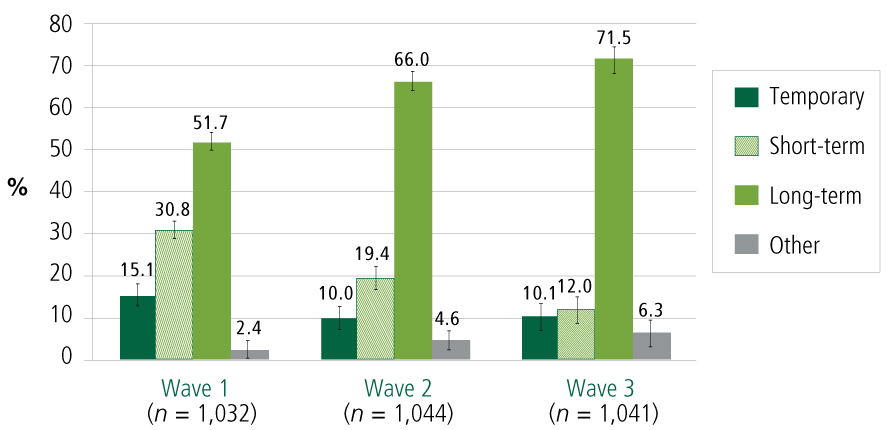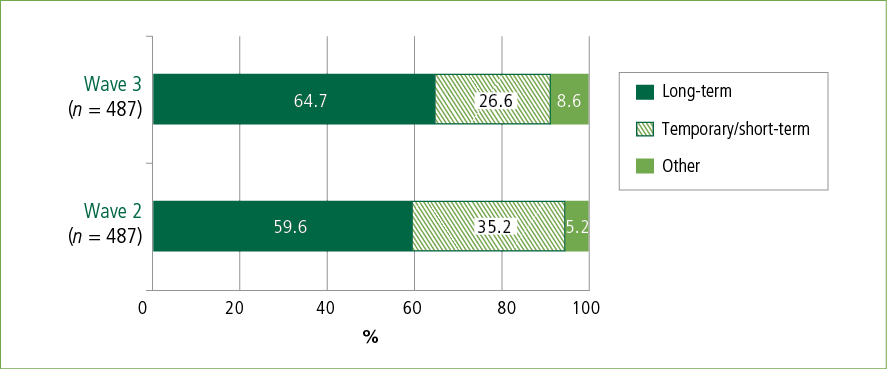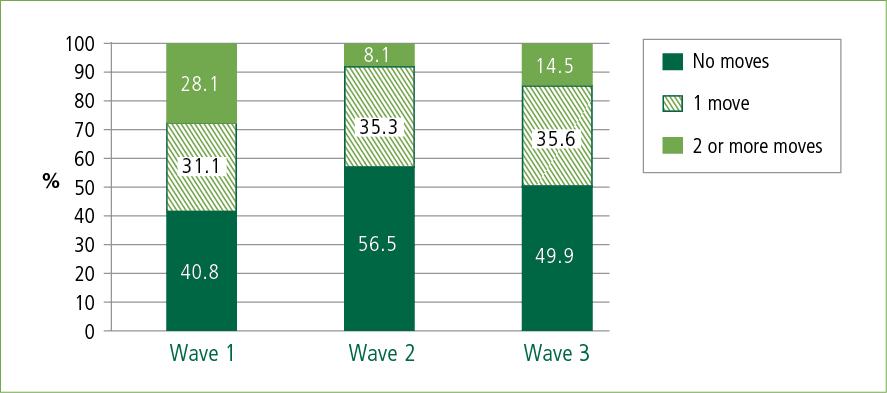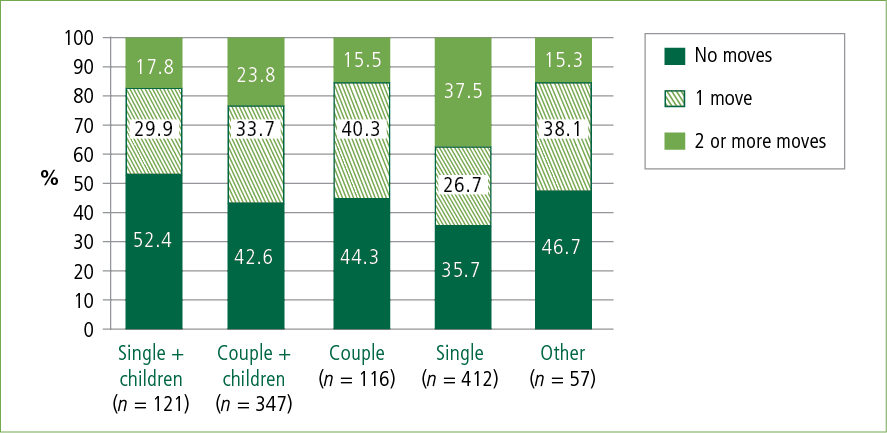Housing outcomes for recently arrived humanitarian migrants
December 2017
John De Maio, Liliya Gatina-Bhote, Cuc Hoang, Pilar Rioseco
Download Research snapshot
Overview
Settlement success for recently arrived humanitarian migrants can be influenced by many factors, including the ability to obtain secure housing (AHURI, 2002). This research summary looks at Building a New Life in Australia (BNLA) participants' housing experiences shortly after arrival in Australia (3-6 months, Wave 1 of the study), and at annual interviews after that (at Wave 2 and Wave 3). We look at housing tenure, assistance received with housing, number of housing moves, difficulties making housing payments (housing stress), and overall housing challenges1.
1 Weighted data are used in this analysis. Analysis was based on 1,053 Principal Applicants who completed a Wave 1, Wave 2 and Wave 3 interview.
Key messages
-
The majority of BNLA participants (about nine in 10) were private renters, and the proportion paying private rent did not change over the first three years of settlement. At Wave 1, which was for most about 3-6 months after arrival in Australia, 52% of Principal Applicants had a long-term lease, with others having a short-term lease, temporary accommodation or other arrangement. This finding largely reflects the housing support provided through the Humanitarian Settlement Services (HSS) program. Most humanitarian migrants are provided with short-term accommodation on arrival and then supported to source and secure longer-term accommodation. Some new humanitarian arrivals will live with their proposer or a family member. By Wave 3 of BNLA, the proportion with a long-term lease had increased to 72%.
-
Over half (59%) of all Principal Applicants reported at Wave 1 that they had moved home at least once since their arrival in Australia. This reflects the movement from temporary to longer-term housing for many supported by the HSS program. At Waves 2 and 3, lower proportions (43% and 50%) had moved home at least once since the previous wave. Migrating units consisting of a single adult had the highest rates of residential mobility. At Wave 1, 64% had moved at least once since arrival in Australia and 38% had moved at least twice.
-
The main sources of help to find housing were family and friends (59%) or a government/case settlement worker (38%). Most BNLA participants were positive about the assistance provided to them by the government/case settlement worker.
-
At Wave 1, eight in 10 BNLA participants reported that finding housing in Australia had been hard or very hard. The main difficulties were related to finding affordable housing, having language difficulties and, at Wave 1, having no rental history or references.
Introduction
Information about housing outcomes was collected from Principal Applicants, who answered questions about housing on behalf of other members of the Migrating Unit participating in the study.2 We report this information here as household level information, meaning the household comprising those of the Migrating Unit who are still living with the Principal Applicant.
The Humanitarian Settlement Services (HSS) program provides housing support to humanitarian migrants (see "Humanitarian Settlement Services: Policy context" box). Many of the BNLA participants would have been HSS clients at the time of the collection of Wave 1 data. Consequently, HSS accommodation assistance provided to clients will be reflected in the responses of BNLA participants. Where applicable, we note how the BNLA findings should be interpreted in the context of this program.
What is the Building a New Life in Australia study?
The Building a New Life in Australia (BNLA) study is tracing the settlement journey of almost 2,400 humanitarian migrants from their arrival in Australia. It will provide a better understanding of the factors that influence their settlement journey. The project will result in a broad evidence base to assist policy development and program improvement for humanitarian migrants in this country.
Study participants come from a wide range of national and cultural backgrounds and comprise humanitarian entrants who arrived in Australia via a number of different migration pathways. This includes those who were granted a humanitarian or refugee visa before their arrival in Australia (85%), hereafter referred to as the offshore group, as well as asylum seekers who sought and were granted a Permanent Protection visa after they had arrived, termed the onshore group (15%). Study members are living in metropolitan and non-metropolitan areas, in all states and territories except the ACT. They are being interviewed once per year.
Key dates for the first three waves of data were:
- Wave 1: Interviews conducted between October 2013 and March 2014 (3–6 months after arrival in Australia for the offshore group or 3–6 months of being granted a permanent visa for the onshore group);
- Wave 2: Interviews conducted between October 2014 and February 2015;
- Wave 3: Interviews conducted between October 2015 and February 2016.3
Many aspects of life are being assessed, including migration pathways and experiences; family demographics; housing and neighbourhood characteristics; English language proficiency and training; engagement in other educational study or training; employment; income; financial hardship; physical and mental health; self-sufficiency; community engagement and support; and perceptions of life in Australia. (For more information, see De Maio, Silbert, Jenkinson & Smart, 2014 or the study’s first Fact Sheet by Jenkinson, Silbert, De Maio & Edwards, 2016).
Humanitarian Settlement Services: Policy context
Department of Social Services
The Department of Social Services (DSS)4 administers the Humanitarian Settlement Services (HSS) program to provide early practical support to humanitarian migrants on arrival, and throughout their initial settlement period, generally for the first six to 12 months.5 HSS providers work with clients to assess and identify needs and deliver a tailored package of services to meet those needs. Relevant to this analysis, services may include help finding suitable accommodation. Many of the BNLA participants would have been HSS clients at the time of the collection of Wave 1 data.6Consequently, HSS accommodation assistance provided to clients will be reflected in the responses of BNLA participants. HSS providers place clients directly into long-term accommodation (LTA) upon arrival or, more commonly, after clients have spent a brief period (typically up to 12 weeks) in short-term accommodation (STA). HSS providers pay the full accommodation costs including utilities (known as the "initial rental payment") for clients, for the first four weeks after their arrival. HSS providers source and secure suitable LTA, consisting of a minimum six-month lease, within six months of the clients' arrival, typically in the private rental market, ensuring all rental properties it provides or arranges are affordable. That is, housing must be within clients' financial means. Many Special Humanitarian Program migrants choose to live with their proposers.7 Other humanitarian migrants might choose to live with family or friends who already reside in Australia. In these scenarios, the HSS provider may not be required to ensure that the HSS client has a formal LTA lease in place. HSS providers also assist clients into a further LTA lease where clients are required to vacate a property. HSS providers are required to ensure that clients are established in LTA, or have other stable accommodation arrangements before clients are exited from the HSS program.
2 Selection into the BNLA study was based on the "Migrating Unit" named on the permanent visa application. A Principal Applicant is the person for whom approval of the permanent visa was based. Secondary Applicants comprise other members of the Migrating Unit named on the visa application (e.g., spouse, children).
3 This information was provided by the DSS. Further information on the HSS program is available at <www.dss.gov.au/our-responsibilities/settlement-and-multicultural-affairs/programs-policy/settlement-services/humanitarian-settlement-services-hss>.
4 From October 2017, the Humanitarian Settlement Services (HSS) program will be replaced by the Humanitarian Settlement Program (HSP).
5 From 30 August 2013, onshore-granted protection visa holders were no longer eligible to receive services under the HSS program. BNLA participants holding the following visa types: Refugee category (subclass 200, 201, 203 and 204 visas) and Global Special Humanitarian (subclass 202) visa were eligible for the HSS program at the time of the Wave 1 interview.
6 Proposers are those persons who propose applicants under the Refugee and Special Humanitarian Programme, including those eligible under the "split family" provisions that apply to immediate family members. Proposals may be submitted by individuals or by organisations operating in Australia.
7 A small number of participants who reported that they did not pay rent or that housing was provided by others were excluded from this analysis. Those reporting "don't know/prefer not to say" were also excluded from this analysis.
Housing tenure
At each of the first three waves of BNLA, 87-88% of Principal Applicants reported that they were paying rent in the private rental market. At Wave 1, 7% were paying rent to the government but this declined to 4-5% at Waves 2 and 3. Very few reported that they were living in a home that they were paying off (1-2% at Waves 1 and 2, and 4% at Wave 3), with the balance paying no rent or housing costs, or instead paying board.
Additional information about humanitarian migrants' housing tenure was collected at Wave 1, 2 and 3 interviews by asking Principal Applicants to report their current housing arrangement as one of:
- temporary (e.g., no contract);
- short-term lease/contract (less than six months);
- long-term lease/contract (more than six months); or
- other.
Figure 1 shows that at Wave 1 of BNLA, 52% had a long-term lease or contract, while 31% had a lease of less than six months and 15% were in temporary accommodation. These findings are not surprising given that at Wave 1 79% of participants had arrived in Australia within the previous six months. Most were therefore still eligible for the practical support offered through the HSS program, including initial short-term accommodation and assistance to find longer-term housing (see HSS box).
At later waves of BNLA, higher proportions had a long-term lease or contract (66% in Wave 2 and 72% in Wave 3). At Wave 3 - two to three years after arrival - 10% were in temporary housing and 12% had a short-term lease or contract.
These findings are consistent with other research that has shown that humanitarian migrant households move from insecure to more secure housing accommodation as their time in Australia increases (Flatau et al., 2015; Beer & Foley, 2003).
To further explore how housing arrangements changed over time, we traced the pathways of those households that were classified as temporary or short-term accommodation at Wave 1, to ascertain their housing arrangements at later waves (e.g., were they still in temporary housing arrangements at Wave 2 and Wave 3?). These data are shown in Figure 2. Of the 487 Principal Applicants in temporary or short-term accommodation at Wave 1, 60% were in long-term housing arrangements a year later at Wave 2. That had increased to 65% at the time of the Wave 3 interview. Looking across the first three waves of data, overall, 5% of Principal Applicants were in temporary or short-term accommodation at all of the first three interviews.
Figure 1: Housing tenure of BNLA participants at Wave 1, Wave 2 and Wave 3

Figure 2: Housing tenure at Waves 2 and 3, of Principal Applicants who were in temporary/short-term accommodation in Wave 1

Assistance to find housing
At Wave 1, Principal Applicants were asked how they had received help in finding housing in Australia. By far, the most frequently reported sources of help were family and friends (59%) and their government/settlement caseworker (38%). Much smaller percentages identified as a source of help: real estate agents (9%); people from their ethnic or religious community (6%); newspaper/Internet (6%); other group or a service (2%). Only 3% reported receiving no help.
Of those who said they were helped by a government/settlement caseworker, 49% said that assistance was very helpful, 33% said it was quite helpful, 13% said it was a little helpful and 5% not at all helpful.
Residential mobility
We can expect some degree of housing mobility among the BNLA sample over their first three years of settlement. In particular, the assistance they receive to find housing early in the settlement journey (see HSS box) may contribute to the mobility of some humanitarian migrants at this time, and may represent a positive outcome as they move to longer-term accommodation.
While some residential mobility is expected, high residential mobility may be a marker of poorer housing outcomes, as it may suggest a degree of difficulty in finding and sustaining long-term or suitable housing arrangements. For example, moving frequently from one form of temporary shelter to another can be the sign of homelessness (Beer, & Foley 2003).
Residential mobility was investigated by analysing self-reported information on how many times the Principal Applicant had moved house after arriving in Australia (at Wave 1), or since the time of their previous interview (at Wave 2 onwards). As can be seen in Figure 3, recently arrived humanitarian migrants in the BNLA were highly mobile.
Residential mobility was highest early in the settlement journey. At Wave 1, 59% had reported moving at least once since arrival. As noted, this may represent moves facilitated through the HSS program from temporary or short-term housing options to longer-term ones.
At Wave 2, a significantly lower proportion (43%) reported having moved at least once since their last interview. By Wave 3, the proportion who had moved at least once since the previous interview was 50%. This difference was significantly lower than the 59% who had this level of residential mobility in Wave 1 but not statistically different to the Wave 2 figure of 43%.
It's important to note that the majority of respondents had only been living in Australia for three to six months at the time of the Wave 1 interview - whereas from Wave 2 onwards, participants were reporting on a nine to 12-month time span between interviews, which makes the subsequent lower rates of moving even more noteworthy.
Further analysis was also undertaken to explore if there were differences in residential mobility at Wave 1 by the type of Migrating Unit (see Figure 4). The Migrating Unit consisted of single adults, with or without children, couple adults with or without children, or other family forms.
If the Migrating Unit consisted of a single person, those participants had the highest rates of residential mobility: 64% had moved at least once since arrival in Australia at Wave 1 and this included 38% who had moved at least twice. The percentage moving at least twice was markedly higher than all other categories.
There were differences across other forms of Migrating Unit in the number of moves they experienced but those who were most likely to have had no moves were single adult household with children, along with those in "other" family forms.
Housing challenges
Noting that most humanitarian entrants are supported through the HSS program to source and secure longer-term housing following their arrival in Australia, at Wave 1, Principal Applicants were asked to rate how easy it had been to find housing in Australia. Overall, 19% said it was easy or very easy, 43% said it had been hard and 39% very hard. The reasons given for housing difficulties were:
- affordability (57% of those reporting finding housing had been hard or very hard);
- language difficulties (54%);
- not having references or a rental history in Australia (48%);
- unaffordable in desired area (42%);
- aspects of the process, e.g. not understanding the forms (23%);
- lack of suitably sized housing, e.g. too small/too big (22%); and
- discrimination (5%).
The question was repeated at Wave 3 but was only asked of those who had moved in the previous year. Of this group, 35% reported it had been easy or very easy to find housing in the previous 12 months, 47% reported it had been hard and 18% reported it had been very hard. Difficulties at this time were concentrated on affordability (52%), language difficulties (43%), affordability in the desired area (41%) and lack of suitably sized housing (28%).
These results are consistent with findings from Ethnic Communities Council of Victoria (2008) research that identified a number of barriers faced by humanitarian migrants in securing housing, especially when competing against working couples in the private rental and home ownership markets. Their research showed that barriers can include: economic disparity and unemployment; a lack of understanding of tenancy laws; and a lack of rental history and references. Experiences of discrimination are another potential disadvantage faced by this group.
The HSS "onshore orientation program" contains a module on renting in Australia that aims to raise awareness and understanding of the challenges and rules surrounding the rental market for recently arrived humanitarian migrants.
Figure 3: Number of times Principal Applicants had moved house since arrival (Wave 1) or since last interview (Waves 2 and 3)

Figure 4: Distribution of number of times Principal Applicants had moved since arrival at Wave 1 by Migrating Unit.

Figure 5: Percentage of households in which participants had difficulties with housing payments 8

8 Respondents were asked "Since arriving in Australia [Wave 1] / In the last 12 months [Waves 2 and 3], has any of the following happened to you because you did not have enough money?", with one option being: "Could not pay the rent or mortgage on time".
Housing stress
As noted above, the lack of access to low-cost housing was the most frequently reported housing difficulty by participants and can present challenges for recently arrived humanitarian migrants. It is a major factor that can lead to housing stress for refugee and humanitarian migrants (Refugee Council of Australia, 2013).
Housing stress was measured by asking survey respondents if they "Could not pay the rent or mortgage on time."9 Those who answered "yes" to this question were classified as having experienced housing stress.
As can be seen in Figure 5, levels of housing stress did not change over time. At Wave 1, participants had difficulties with housing payments in 11% of households. This proportion remained steady in the following two waves, meaning that there was no improvement in levels of housing stress over time for survey participants. Comparison of the BNLA data with results from other Australian population surveys shows that recently arrived humanitarian migrants were twice as likely to struggle with housing payments relative to other Australians.10
9 See Bennetts Kneebone (2014). Results from this survey question in the BNLA were compared to the same question asked in the Longitudinal Study of Australian Children (LSAC) and Household Income and Labour Dynamics in Australia (HILDA). As the author notes, the surveys are not directly comparable but give an insight into the experience of these different populations. The proportion who reported housing stress at Wave 1 in Bennetts Kneebone (2014) was 13%. This figure differs slightly from the 11% reported here, as our analysis is based on a different sub-population of those who completed all three interview waves.
10 See Bennetts Kneebone (2014). Results from this survey question in the BNLA were compared to the same question asked in the Longitudinal Study of Australian Children (LSAC) and Household Income and Labour Dynamics in Australia (HILDA). As the author notes, the surveys are not directly comparable but give an insight into the experience of these different populations. The proportion who reported housing stress at Wave 1 in Bennetts Kneebone (2014) was 13%. This figure differs slightly from the 11% reported here, as our analysis is based on a different sub-population of those who completed all three interview waves.
Summary
Building a New Life in Australia is a rich study that can provide valuable insights into how humanitarian migrants are faring in their settlement journey. This research summary has focused on housing experiences using the first three waves of the study.
Almost half of BNLA Principal Applicants indicated at Wave 1 that they were living in a housing arrangement involving temporary accommodation or a short-term lease. These arrangements are likely to reflect the HSS program context in which newly arrived humanitarian migrants commonly spend some time in short-term accommodation, or spend time living temporarily with a proposer or with a family member or friend, before moving on to longer-term accommodation. During the post-arrival period, HSS providers are actively seeking longer-term accommodation arrangements for the client. The longer they were in Australia, the more likely BNLA participants were to move into secure housing arrangements.
It was common for BNLA Principal Applicants to report that they had help from others to find housing. At Wave 1, this help was typically provided by family or friends, and/or a government/settlement caseworker. Most participants found the assistance provided by a government/settlement caseworker to be helpful.
Recently arrived respondents were highly mobile, with almost six in 10 having moved house at least once in the three to six months after arrival. This reflects the HSS process by which providers move clients from short-term to long-term accommodation. Higher residential mobility was more evident earlier on in the settlement journey, with some differences across different types of Migrating Units.
Most BNLA Principal Applicants reported that they had experienced some difficulties in finding housing. These included difficulties related to the affordability of housing, language difficulties and lacking references or rental history. A specific source of financial stress for BNLA participants was meeting housing costs, with around one in 10 reporting difficulties with housing payments at Wave 1. This level of housing stress remained steady in later waves. Comparison of BNLA data with other survey results also showed that humanitarian migrants were twice as likely to be having difficulties with housing payments than other groups in Australia.
Access to the BNLA data
The analyses reported here are based on Waves 1-3. The first three waves of BNLA data are now available to approved researchers from government, academic institutions and non-profit organisations. Details on how to apply for the BNLA data are available on the Department of Social Services website <www.dss.gov.au/our-responsibilities/families-and-children/ programmes-services/access-to-dss-longitudinal-datasets>.
References
- AHURI. (2002). The role of housing and other services in successful settlement of new arrivals in Australia. AHURI Research and Policy Bulletin. Issue 14, November. Melbourne: Australian Housing and Urban Research Institute.
- Beer, A., & Foley, P. (2003). Housing need and provision for recently arrived refugees in Australia (AHURI Final Report No. 48). Melbourne: Australian Housing and Urban Research Institute. Retrieved from <www.ahuri.edu.au/research/final-reports/48>.
- Bennetts Kneebone, L. (2014). Financial hardship in Australia (Data Highlight). Canberra: Department of Social Services, National Centre for Longitudinal Data. Retrieved from <www.dss.gov.au/.../data-highlights-no1/2014-financial-hardship-in-australia>.
- De Maio, J., Silbert, M., Jenkinson, R., & Smart, D. (2014). Building a New Life in Australia: Introducing the Longitudinal Study of Humanitarian Migrants. Family Matters, 94, 5-14.
- Ethnic Communities Council of Victoria. (2008). Availability, affordability, accessibility: Housing Victoria's new migrant and refugee communities. Discussion Paper. Statewide Resources Centre, Ethnic Communities Council of Victoria. Retrieved from <ecv.org.au/library/file/policy/ECCV_Discussion_Paper_Housing_Victorias_New_Migrant_and_Refugee_Communities.pdf>.
- Flatau, P., Smith, J., Carson, G., Miller, J., Burvill, A., & Brand, R. (2015). The housing and homelessness journeys of refugees in Australia: Final report. Perth: Australian Housing and Urban Research Institute, University of Western Australia.
- Jenkinson, R., Silbert, M., De Maio, J., & Edwards, B. (2016). Settlement experiences of recently arrived humanitarian migrants (Building a New Life in Australia fact sheet). Melbourne: Australian Institute of Family Studies.
- Refugee Council of Australia. (2013). Housing issues for refugees and asylum seekers in Australia: A Literature Review. Retrieved from <www.refugeecouncil.org.au/r/rpt/1309_HousingLitRev.pdf>.
Background
This paper uses unit record data from the Building a New Life in Australia (BNLA). The study is conducted in partnership between the Department of Social Services (DSS) and the Australian Institute of Family Studies (AIFS). The findings and views reported in this paper, however, are those of the author and should not be attributed to DSS or AIFS. This research summary was commissioned by Settlement Policy Section, DSS. We thank DSS staff for their input to this research.
We extend very special thanks to the humanitarian migrants who participated in this study, especially for their wonderful support and generosity of time. We look forward to continuing to talk with them about their settlement journey in Australia.
Featured image: © iStock/vale_t
De Maio, J., Gatina-Bhote, L., Hoang, C., & Rioseco, P. (2017). Housing outcomes for recently arrived humanitarian migrants (Building a New Life in Australia Research Summary). Melbourne: Australian Institute of Family Studies.
978-1-76016-159-0
Download Research snapshot
Related publications

Settlement experiences of recently arrived humanitarian…
Wave 1 findings from the Building a New Life in Australia (BNLA) longitudinal study.
Read more
Risk of psychological distress among recently arrived…
This Research Summary explores participants' risk of psychological distress shortly after arrival in Australia and at…
Read more
Recently arrived humanitarian migrants
This research summary explores the factors affecting the settlement success of humanitarian migrants.
Read more